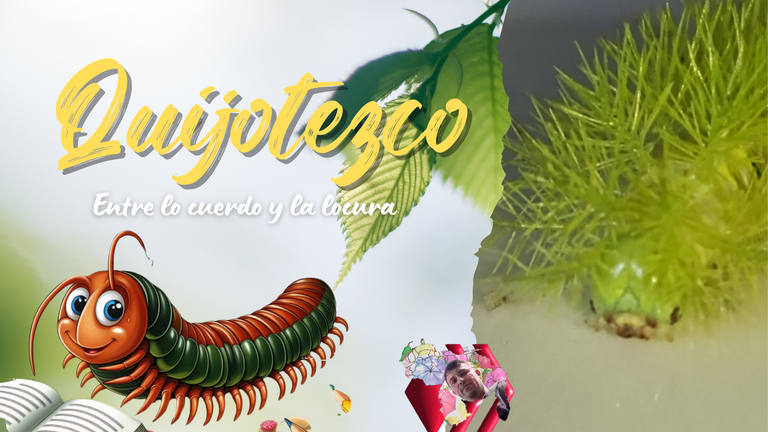

Bienvenidos

Welcome
Hola!
Nuevamente por acá escribiendo un poco sobre lo sorpresivo de la naturaleza, sobre todo cuando menos lo esperas y de repente llegan a ti con la intensión de saludarte o simplemente para decir; - epa! Aquí estoy, mírame…
En esta oportunidad, estaba en uno de esos días de lectura sobre el mesón de la cocina, cuando de la nada apareció esta pequeña oruga verde con su arquitectura despampanante, que de seguro a muchos puede asustar, una perfecta composición de filamentos puntiagudos de color verde manzana, como si fuese sacado de una película de suspenso y terror.
De verdad que es un insecto impresionantemente hermoso, que iba caminando como un pequeño resorte sobre el mesón, como si por dentro fuese un acordeón, que al observarlo detenidamente, la forma en la cual tenía dispuesta los filamentos indicaba que posiblemente se le tenía que tener cuidado.
Esta pequeña oruga es un insecto que tiene unas de las etapas más fascinantes del ciclo de vida de las polillas o mariposas, que son definidos científicamente como lepidópteros, que dependiendo de su especie, pueden presentar una gran gama de colores y estructuras corporales que, repito, son sacadas de una película de ciencia ficción, que además cumplen funciones ecológicas específicas. La oruga verde con espinas es un claro ejemplo de cómo la naturaleza ha desarrollado mecanismos de defensa visual y químico para garantizar su supervivencia.
Como lo mencione, esta oruga pertenece científicamente al orden Lepidoptero, el mismo al que pertenecen las mariposas y polillas. y que dentro de este grupo, existen muchas especies de orugas que han evolucionado para tener sus cuerpos cubiertos de espinas, pelos o estructuras urticantes. Es posible que esta oruga pertenezca a la familia Limacodidae (ver: https://es.wikipedia.org/wiki/Limacodidae), también conocida como "orugas de copa" o "gusanos látigo", por sus características llamativas y espinas venenosas, ya que poseen toxinas en sus espinas que pueden causar irritación en la piel de nosotros los humanos y otros animales. Su coloración vibrante es una clara advertencia para los depredadores, indicando que no son una presa fácil.
Sin embargo la tome y la puse en mi mano para llevarla a otro sitio donde pudiese buscar donde sujetarse para transformarse de oruga a polilla, un sitio donde su color le permitiera camuflarse entre la vegetación.
Pensar que en su proceso de vida iba a transformarse en una polilla es fascinante, la metamorfosis es su fin último, por lo cual la admiro y respeto
Algo que me llamo poderosamente la atención al indagar sobre esta oruga (ver: https://discover.hubpages.com/living/Green-Caterpillar-Identification), es que sus colores brillantes y estructura espinosa son comunes en regiones tropicales y subtropicales, especialmente en América Latina. Prefieren ecosistemas con una gran variedad de plantas, ya que su alimentación depende la diversidad vegetal del entorno. Su presencia en estos ecosistemas indica una buena salud ambiental, ya que desempeñan un papel crucial en la cadena alimenticia y en la regeneración de la vegetación, además de que participan en la descomposición de materia vegetal y sirven de alimento para múltiples especies.
Otra cosa que pude indagar en la web (ver: https://es.wikipedia.org/wiki/Oruga_(larva))fue que en su proceso de oruga a pupa o crisálida y por último transformación es en una polilla nocturna y que varias de sus especies pueden producir urticaria como defensa ante las amenazas.
Por acá les dejo esta hermosa oruga en fotos.
Hello!
Here I am again, writing a little about the surprises of nature, especially when you least expect it and suddenly they come to you with the intention of greeting you or just to say; - hey! Here I am, look at me...
In this opportunity, I was in one of those days of reading on the kitchen counter, when out of nowhere appeared this little green caterpillar with its stunning architecture, which surely can scare many, a perfect composition of spiky filaments of apple green color, as if it was taken out of a thriller and horror movie.
It really is an impressively beautiful insect, which was walking like a small spring on the table, as if it were an accordion inside, and when observing it carefully, the way in which the filaments were arranged indicated that it might have to be taken care of.
This small caterpillar is an insect that has one of the most fascinating stages of the life cycle of moths or butterflies, which are scientifically defined as lepidoptera, which, depending on their species, can present a wide range of colors and body structures that, I repeat, are taken out of a science fiction movie, which also fulfill specific ecological functions. The green caterpillar with spines is a clear example of how nature has developed visual and chemical defense mechanisms to guarantee its survival.
As I mentioned, this caterpillar belongs scientifically to the order Lepidoptera, the same order to which butterflies and moths belong, and within this group, there are many species of caterpillars that have evolved to have their bodies covered with spines, hairs or stinging structures. It is possible that this caterpillar belongs to the family Limacodidae (see:https://es.wikipedia.org/wiki/Limacodidae), also known as “cup caterpillars” or “whipworms,” because of their striking features and poisonous spines, as they possess toxins in their spines that can cause skin irritation to us humans and other animals. Their vibrant coloration is a clear warning to predators, indicating that they are not easy prey.
However, I picked it up and placed it in my hand to take it to another place where it could find a place to attach itself to transform from caterpillar to moth, a place where its color would allow it to camouflage itself among the vegetation.
To think that in its life process it was going to transform into a moth is fascinating, metamorphosis is its ultimate goal, for which I admire and respect it.
Something that caught my attention when researching this caterpillar (see: https://discover.hubpages.com/living/Green-Caterpillar-Identification), is that its bright colors and spiny structure are common in tropical and subtropical regions, especially in Latin America. They prefer ecosystems with a great variety of plants, since their diet depends on the plant diversity of the environment. Their presence in these ecosystems indicates good environmental health, since they play a crucial role in the food chain and in the regeneration of vegetation, in addition to participating in the decomposition of plant matter and serving as food for multiple species.
Another thing I was able to find out on the web (ver: https://es.wikipedia.org/wiki/Oruga_(larva))was that in its process from caterpillar to pupa or chrysalis and finally transformation into a nocturnal moth and that several of its species can produce hives as a defense against threats.
Here are some photos of this beautiful caterpillar.
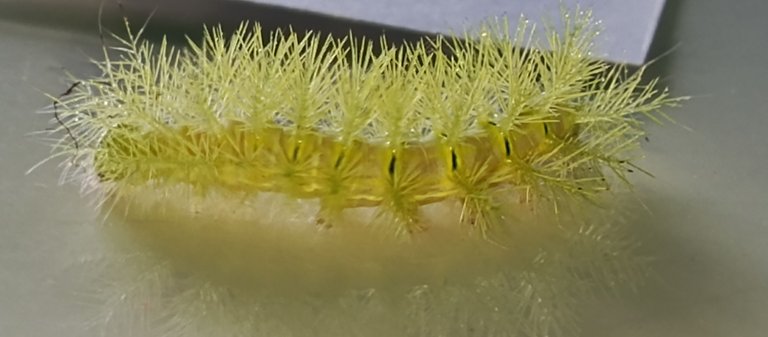
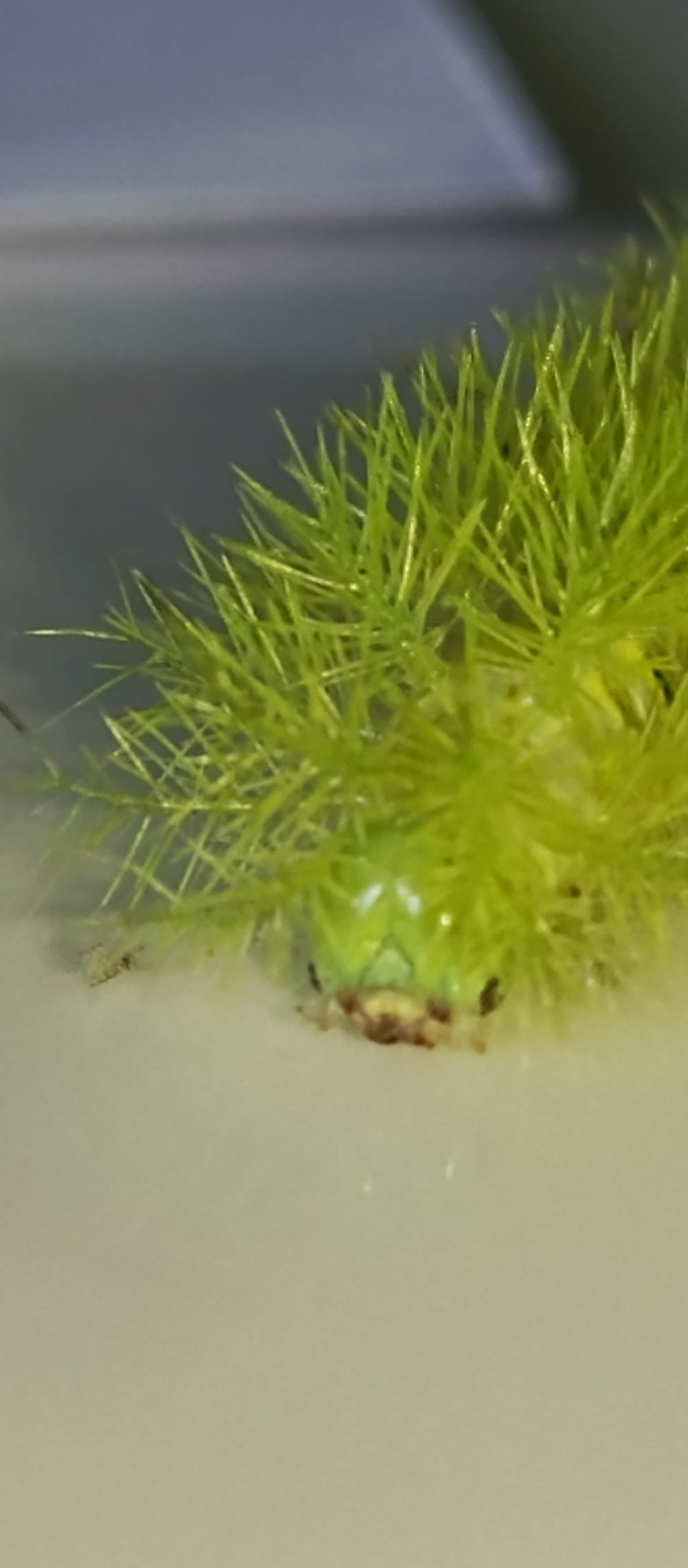
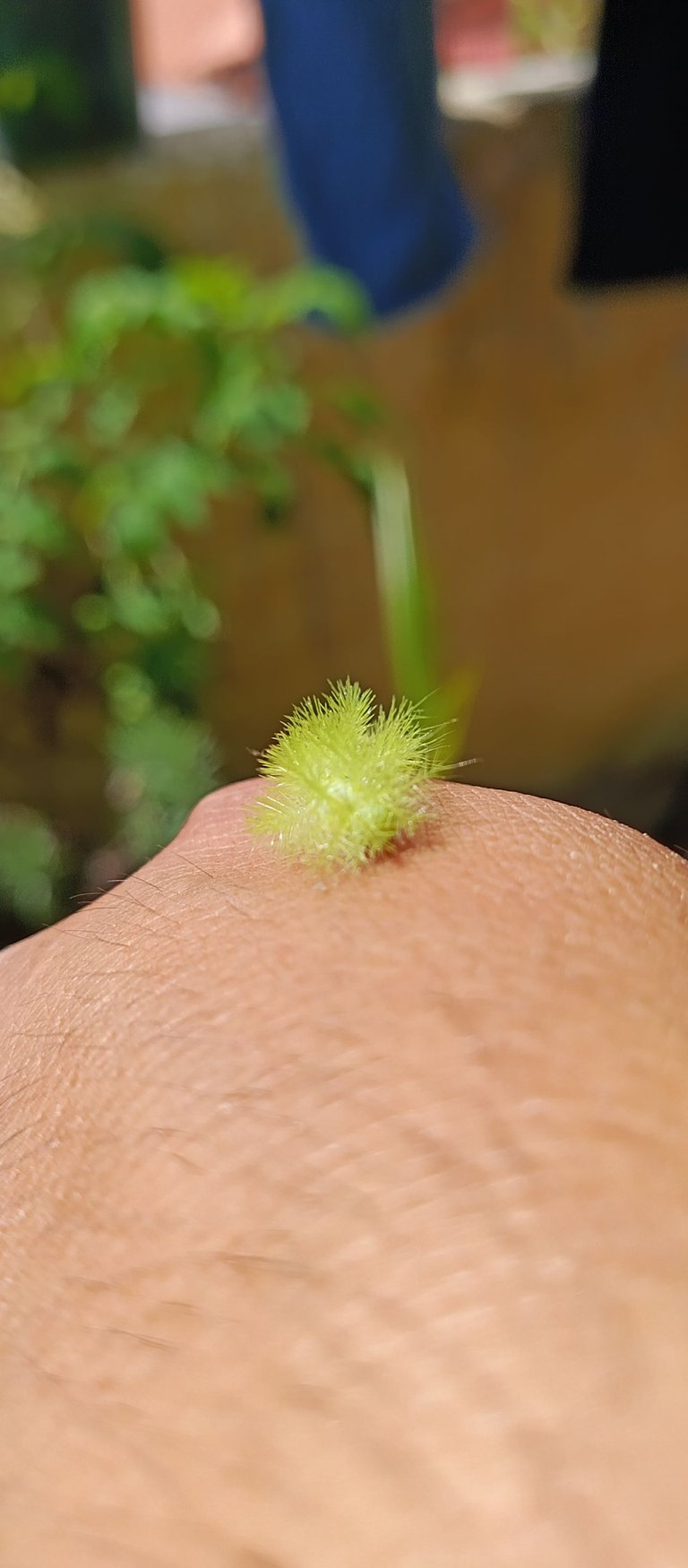
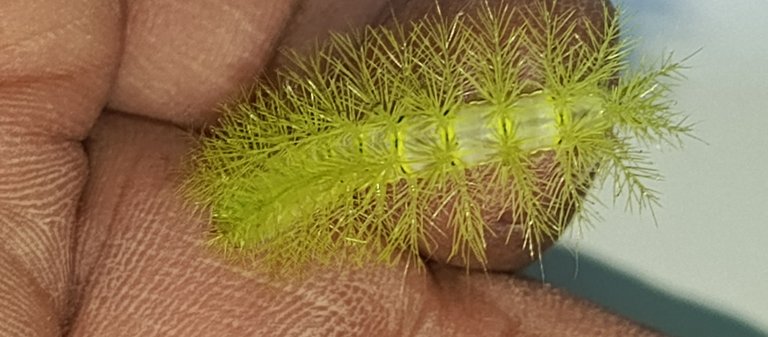

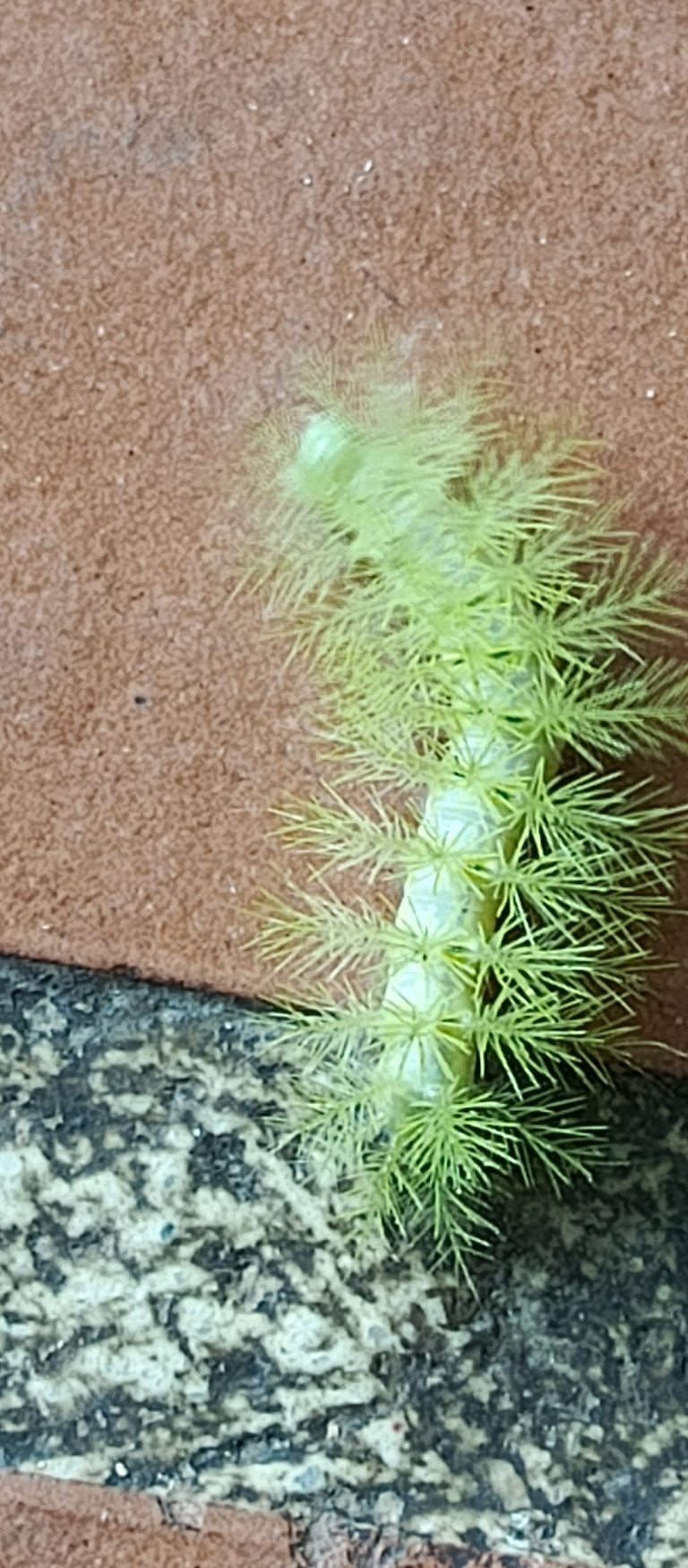

Gracias por leer y votar este post...
Un abrazo!
Hasta otra oportunidad!

Thank you for reading and voting this post...
A hug!
See you again!
La imagen principal del post fue creada por Diseñador
Designer Con tecnología de DALL·E 3 y editada con Canva
The main image of the post was created by Designer
Designer With DALL-E 3 technology and edited with Canva
Los separadores fueron hechos con Canva.
The dividers were made with Canva.
Para este post me apoye en Translated with www.DeepL.com/Translator (free version)
For this post I relied on Translated with www.DeepL.com/Translator (free version)
Nota: todas las imágenes son de mi propiedad, tomadas con mi movil Mi 11 Lite
Note: all images are my property, taken with my Mi 11 Lite mobile phone.

¡Felicitaciones!
1. Invierte en el PROYECTO ENTROPÍA y recibe ganancias semanalmente. Entra aquí para más información.
3. Suscríbete a nuestra COMUNIDAD, apoya al trail de @Entropia y así podrás ganar recompensas de curación de forma automática. Entra aquí para más información sobre nuestro trail.
4. Creación de cuentas nuevas de Hive aquí.
5. Visita nuestro canal de Youtube.
Atentamente
El equipo de curación del PROYECTO ENTROPÍA
It would be interesting to see what comes out of that beautiful caterpillar. I've already seen super pretty caterpillars and ugly butterflies, hehe. / seria interesante ver que sale de esa hermosa oruga, ya vi orugas super bonitas y la mariposas feas jeje
Hello there! good post but is missing the source information, can you please add it on your post? 😃
of course.... already put the references that helped me to write my post
Done! and a thousand apologies...
:)